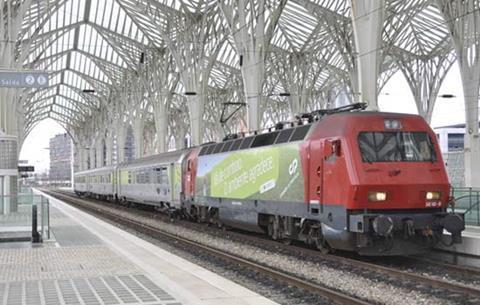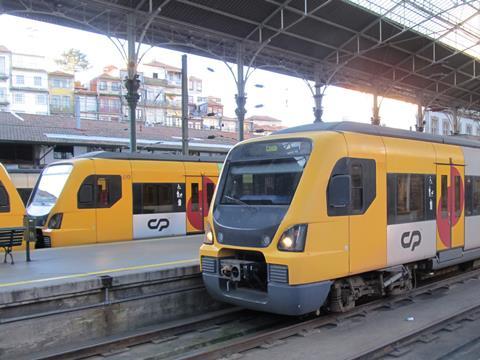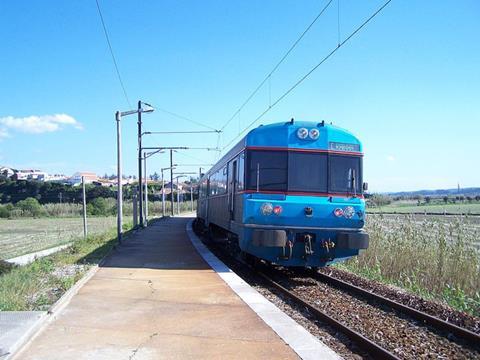
PORTUGAL: The government has confirmed its intention to press ahead with rail investment totalling more than €10bn as part of a wider national stimulus programme. The highlight of the package is the revival of a proposal for a high speed rail link between Lisboa and Porto, which was the subject of extensive studies in the mid-2000s.
Prime Minister António Costa and Minister of Infrastructure & Housing, Pedro Nuno Santos were among the dignitaries to formally launch the PNI2030 plan in Lisboa at the end of October. It envisages the delivery of 16 rail projects worth €10∙5bn in the next decade, financed from both the national budget and EU sources.
Almost half of the allocation, €4∙5bn, is dedicated to building a new line between Porto and Lisboa. This would be delivered in multiple phases, and it is likely to feature multiple connections with the existing main line between the country’s two largest cities, where Alfa Pendular tilting trains can already run at up to 225 km/h in places.
The initial section to be built is expected to link Gaia, south of Porto, with Soure, which would account for approximately half the distance between the cities. The new alignment would initially be built as 1 668 mm gauge with a maximum operating speed of 250 km/h, but with passive provision for later upgrading to 1 435 mm gauge and 300 km/h operation as the rest of the line is completed.
The government has set a target Lisboa - Porto journey time of approximately 1 h 15 min. Development of the high speed line is likely to make extensive use of the previous feasibility studies, and two bridges are likely to be built to take the line over the Douro and Tagus rivers.
PNI2030 also raises the prospect of a longer term northern extension of the line towards Vigo in Spain as what the government terms the Eixo Atlântico corridor.
This would also be built in phases, starting with a Braga – Vigo route provisionally costed at €900m that would link the two cities in 30 min; Braga – Porto would be built later to deliver a planned 1 h journey time between Porto and Vigo.
Enhancing suburban corridors
The PNI2030 plan commits funding to a raft of enhancements across the network which had already been identified as priority projects.

Among them is four-tracking several sections of the busy suburban routes around Lisboa and Porto (€290m), including the Roma-Areeiro - Braço de Prata section of Lisboa’s orbital corridor, from which connections would be built to enable trains to reach the main port and the currently isolated Cascais branch.
In the Porto metropolitan area, the Contumil - Ermesinde section of the north-south main line is to be quadrupled, passenger services reintroduced on the Leixões line and a main line link built to the city’s Francisco Sá Carneiro airport.
A further €270m is to be allocated to the roll-out of ETCS and GSM-R across 10 routes, reflecting the need to enhance interoperability with the rest of Europe.
More electrification
A further €740m is allocated to electrification and enhancements away from the major conurbations, as well as some reopening schemes subject to completion of feasibility studies.
Among the projects to be delivered is electrification of the Douro Valley line between Régua and Pocinho and potential reopening to the Spanish border at Barca d’Alva; electrification of the coastal line between Caldas da Rainha and Louriçal, and the renewal and double tracking of the branch from Alfarelos to allow the operation of 750 m long freight trains.
In the east, electrification is planned between Abrantes and Elvas and on the moribund branch to Neves Corvo, as well as the reopening and electrification of the Alentejo line between Beja and Ourique which was closed in 2011.
For freight, there is a €200m package to improve access to ports and terminals as well as to build a new intermodal hub at Castanheira do Ribatejo, north of Lisboa.
In the south of the country, €230m is to be spent by 2025 to electrify the Casa Branca - Beja section of the Alentejo corridor, while the line between Torre Vã and Tunes is to see track and signalling renewals.
Also by 2025, a €100m package of renewals and electrification is to be delivered for the 90 km metre gauge line linking Aveiro and Espinho via Sernanda do Vouga.
New lines proposed
A number of new lines are also proposed by PEI2030, subject to further study. One would be a 36 km line to serve the Vale do Sousa area northeast of Porto, one of the few regions of the country with a young and growing population.

This would diverge from the Douro line at Valongo to serve Felgueiras and Amarante; the mothballed branch between Amarante and Livração would also be reopened. The new line is expected to cost between €200m and €300m.
The government has also recommended that the proposed second phase of the North International Corridor be taken forward despite it being turned down for EU funding on multiple occasions.
Expected to cost around €600m, this cut-off would link Aveiro with Mangualde, where it would meet the route from Pampilhosa to the border at Vilar Formosa. This is currently being refurbished under the first phase of the NIC programme.
A further €150m is programmed for the ongoing South International Corridor scheme to support construction of a new electrified line between the port of Sines and Grândola, as well as double-tracking between Poceirão and Bombel.
Both of these corridors are being developed to support growth in intermodal traffic between Portuguese ports and destinations in Spain and further east.
Rolling stock investment
The PNI2030 plans also cover renewal of the passenger rolling stock fleet under a package worth an indicative €1∙7bn.
Some €680m is earmarked for procurement of 62 suburban multiple-units, 30 of which are to replace the 70 year-old Cascais Line fleet and the remainder would reinforce urban services around Lisboa and Porto.
A further €650m would fund 12 high speed trainsets capable of speeds up to 300 km/h, which would be procured as the Lisboa – Porto and Braga – Vigo projects proceed; delivery is expected by 2029. The plan includes an option for another 14 units.
Thirdly, an investment of €385m would cover 55 regional EMUs to be delivered between 2024 and 2030 to support the extension of electrification across the network.
National plan
In addition to the PNI2030 plans, the government is continuing its consultation process with a view to launching a National Railway Plan in early 2021, when Portugal assumes the Presidency of the Council of the European Union.

The plan is intended to set out an integrated vision for the national network focused on ‘interoperability’ between rural and urban areas, and across the different regions of the country.
Among the plan’s core objectives is to serve all the regional capitals by rail, ensure more effective Iberian cross-border connections, and to integrate Portugal into the trans-European network for both passenger and freight traffic. The plan will also assess the future for secondary and rural railways, with a view to identifying those with the greatest potential for tourism or heritage services.
- An interview with Nuno Freitas, President of national operator CP, will appear in the January 2021 issue of Railway Gazette International magazine.

















